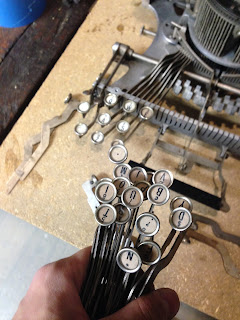The Hammond Multiplex Typewriter
I'm sure most of you are familiar with the famed Hammond Typewriter. The photo above was taken on medium format film for those of you who are interested (pardon the dust removal software glitch). Another article for another time (The Hasselblad Stigma). The Hammond typewriter is famous in its own right, being one of the few successful alternatives to standard typebar machines--it employed a type shuttle. A shuttle is a curved section of rubber or metal with the letter slugs on the face, this feature allowed the Hammond to accommodate different styles of text, fonts, and dialects. All one had to do was swap the shuttle out. It became a beloved machine of doctors and mathematicians, who bought up shuttles with obscure little symbols that only they seemed to know the meaning of. It also attracted the attention of famed author J.R.R. Tolkien, who wrote the Lord of the Rings and the Hobbit on a Hammond typewriter. The story behind the maker of these fantastic machines, John Hammond is even more interesting, but that is not for now. Instead, I'd refer you to my good friend (and prolific Hammond expert) Jon Posey. He has a shrine complete with candles, and recently did a few segments for the Austin Typewriter Podcast (do check them out), but I digress.
Anyway, the above machine, as Jon tells me, is a Hammond Portable. It features a folding space bar and the bottom half to a case, and is held down by four square bolts. This was a serious restoration project for Richard Mohlman, an avid seller and collector. I was happy to take on the task of tearing the machine down to its base and putting it back together cleaner than it was before (obviously). But enough of that, here's some more pictures.
Prior to the repairs, I removed all the external body panels. There are three, the front cover, the top of the carriage, and the rear panel. All three of these were cleaned and waxed, without paint touch up. The rest of the machine came apart easily. The ribbon cups and spool system are removed via the set screws on the collars on the posts, and the gears on the bottom underneath the machine. Once those are out, the two large screws at the base of the type cage can be removed, as well as the tiny nut underneath the machine that holds the central bar (situated by the gap in the center of the springs seen above). With these three points lose, the entire cage assembly lifts off. Make sure the lacquered plate on top of the cage is removed, along with the bearing wheel just underneath it that rides along the carriage. After that is done, the two clips holding the carriage down to the rails can be taken off, and the entire carriage assembly removed from the base of the machine. The ball bearings are set, and don't bounce away on this particular model.
After those two sections are removed, the keys lift right out without a problem. I wasn't being paid to do a large amount of cosmetic work to this machine, so I just hit them with a wire brush to clear the grime off. This machine was missing the right hand Shift key, but it was not up to me to source that. I heard later on that Jon had traded in his spare for something trivial and stupid...
My first order of attack was the carriage. I hit the entire thing with steel wool, including the platen and single feed roller. The carriage return leaver has a finicky screw inside of it that's a pain to reattach, so pay attention to how it comes out when you remove it. The top plate was polished, and the internal mesh cylinder for the paper was de-rusted and scrubbed with soapy water. Once everything was put back together, I was surprised at how nicely it looked :)
I hit the frame with a wire brush and the escapement was hand cleaned with a brush as well. Denatured alcohol and lots of tedious work. After that the keys were lain back in and everything else was pieced back together. I do want to note the adjustment screw on the back of the machine had to be fiddled with to get it typing smoothly. Its located on the back, and identified by the large spring holding it down which runs along the bottom of the typewriter.
After all was done, I began to type. Notice the shuttle? I was surprised. Double Gothic. I can't say its the fastest or most efficient machine made, when one letter is pressed it raises a pin that the shuttle sweeps to one side and hits. It always returns to center, though if another key is pressed in quick secession before it returns to center, it can easily jam the machine. One nice thing about it is the spring loaded action. It gives you an even impression regardless of how hard you press the keys. It hammers the page into the type, rather than the type into the page as on a traditional machine. All in all I enjoyed using the machine for a few days after I was done with the work. I hope it finds a good home and I may consider picking one up for personal use some day in the future.
Oh my god....I had no idea i could imbed videos....well...Enjoy!!!
















Comments
Post a Comment